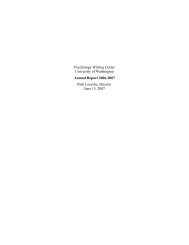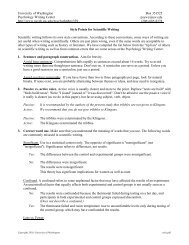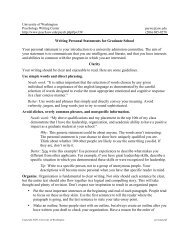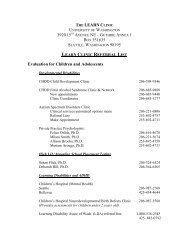Writing an Empirical Paper in APA Style - University of Washington ...
Writing an Empirical Paper in APA Style - University of Washington ...
Writing an Empirical Paper in APA Style - University of Washington ...
You also want an ePaper? Increase the reach of your titles
YUMPU automatically turns print PDFs into web optimized ePapers that Google loves.
<strong>University</strong> <strong>of</strong> Wash<strong>in</strong>gton<br />
Psychology <strong>Writ<strong>in</strong>g</strong> Center<br />
http://www.psych.uw.edu/psych.php#p=339<br />
Box 351525<br />
psywc@uw.edu<br />
(206) 685-8278<br />
• Describe all results that are directly related to your research questions or hypotheses. Start with hypotheses<br />
you were able to support with signific<strong>an</strong>t statistics before report<strong>in</strong>g nonsignific<strong>an</strong>t trends. Then describe <strong>an</strong>y<br />
additional results that are more <strong>in</strong>directly relev<strong>an</strong>t to your questions.<br />
• If you present m<strong>an</strong>y results (i.e., m<strong>an</strong>y variables or variables with m<strong>an</strong>y levels), write a brief summary, then<br />
discuss each variable <strong>in</strong> separate subsections.<br />
• Report ma<strong>in</strong> effects before report<strong>in</strong>g contrasts or <strong>in</strong>teractions. Briefly mention problems such as reasons for<br />
miss<strong>in</strong>g data, but save discussion <strong>of</strong> the problems for the discussion section.<br />
• Use tables <strong>an</strong>d figures to summarize data. Include descriptive statistics (such as me<strong>an</strong>s <strong>an</strong>d st<strong>an</strong>dard<br />
deviations or st<strong>an</strong>dard errors), <strong>an</strong>d give signific<strong>an</strong>ce levels <strong>of</strong> <strong>an</strong>y <strong>in</strong>ferential statistics. The goal is to make<br />
your results section both succ<strong>in</strong>ct <strong>an</strong>d qu<strong>an</strong>titatively <strong>in</strong>formative (see our h<strong>an</strong>dout, "<strong>APA</strong> Table Guidel<strong>in</strong>es").<br />
• For each test used, provide degrees <strong>of</strong> freedom, obta<strong>in</strong>ed value <strong>of</strong> the test, <strong>an</strong>d the probability <strong>of</strong> the result<br />
occurr<strong>in</strong>g by ch<strong>an</strong>ce (p-value). Here are examples <strong>of</strong> the results <strong>of</strong> a t-test <strong>an</strong>d <strong>an</strong> F-test, respectively: t(23) =<br />
101.20, p < .001; F(1, 3489) = 7.94, p < .001 (see also our h<strong>an</strong>dout on report<strong>in</strong>g statistical results <strong>in</strong> <strong>APA</strong><br />
format).<br />
Discussion<br />
In this section, <strong>in</strong>terpret your results by relat<strong>in</strong>g them to your hypotheses. Use words to expla<strong>in</strong> the qu<strong>an</strong>titative<br />
<strong>in</strong>formation from the results section.<br />
Requirements<br />
Discuss the results <strong>in</strong> relation to each hypothesis. This is the most import<strong>an</strong>t part <strong>of</strong> the Discussion section.<br />
Discuss possible expl<strong>an</strong>ations for your results. This part should follow from the predictions you made<br />
earlier based on possible outcomes <strong>of</strong> the study. Do the results agree or disagree with the ideas that you<br />
<strong>in</strong>troduced <strong>in</strong> the Introduction? How do the results relate to previous literature or current theory? Identify <strong>an</strong>d<br />
discuss limitations <strong>in</strong> the experimental design that may reduce the strength <strong>of</strong> your results. Generalize your<br />
results. This is where you tell the reader the extent to which your study is externally valid. Discuss strengths<br />
<strong>an</strong>d weaknesses <strong>of</strong> apply<strong>in</strong>g your results to, for example, <strong>an</strong>other population, species, age, or sex.<br />
Identify followup experiments. Introduce new ideas that your results suggest, <strong>an</strong>d propose ways to test them.<br />
How to Proceed<br />
• Expla<strong>in</strong> whether your results support the hypotheses.<br />
• Discuss how the results relate to the research question <strong>in</strong> general.<br />
The results are consistent with the Yerkes-Dodson law.<br />
These results show the adv<strong>an</strong>tage <strong>of</strong> us<strong>in</strong>g a secondary reaction time paradigm for assess<strong>in</strong>g cognitive load dur<strong>in</strong>g read<strong>in</strong>g.<br />
The f<strong>in</strong>d<strong>in</strong>g that the <strong>in</strong>f<strong>an</strong>t monkeys <strong>in</strong>creased their food <strong>in</strong>take <strong>in</strong> the low-calorie condition <strong>an</strong>d reduced food <strong>in</strong>take <strong>in</strong> the highcalorie<br />
condition is consistent with the hypothesis that pigtailed macaques adjust their food <strong>in</strong>take to ma<strong>in</strong>ta<strong>in</strong> a const<strong>an</strong>t level <strong>of</strong><br />
caloric <strong>in</strong>take. Although the difference between the two conditions decreased across time, however, the <strong>in</strong>f<strong>an</strong>ts consumed more<br />
calories <strong>in</strong> the high-calorie condition th<strong>an</strong> the low-calorie condition.<br />
• If you had a directional hypothesis <strong>an</strong>d your results didn't turn out as expected, discuss possible expl<strong>an</strong>ations<br />
as to why, <strong>in</strong>clud<strong>in</strong>g un<strong>an</strong>ticipated shortcom<strong>in</strong>gs <strong>in</strong> the design, problems such as equipment failure, or even<br />
Copyright 2010, <strong>University</strong> <strong>of</strong> Wash<strong>in</strong>gton <strong>APA</strong>paper.pdf










